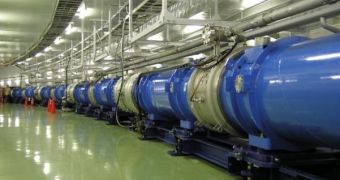Scientists in the Asian nation are excited about the fire-up of their latest synchotron, a particle accelerator featuring a 30-GeV Main Ring. The J-PARC (Japan Proton Accelerator Research Complex) is managed by a multi-national T2K neutrino collaboration, and has over the weekend made its first neutrino observations. The instrument will be used to answer a number of burning questions about the distribution of matter within the Universe, questions that are at this point unanswered by existing observatories, ScienceDaily reports.
The first experiments at J-PARC produced a large number of elementary particles known as pions, which were generated when protons accelerated in the Main Ring were slammed into a carbon target. The small, charged particles were then made to travel through a vessel containing pure helium. Inside the vessel, they decayed to form the elusive elementary particles known as neutrinos, which have some amazing properties in their natural state. They travel close to the speed of light, have a neutral electrical charge, and can pass through ordinary matter as if it wasn't there, without suffering any changes.
Radioactive decay and certain types of nuclear reactions are, at this point, the only known source for neutrinos. They are also produced when high-energy cosmic rays hit atoms. Each of the formation mechanisms dictates the neutrino's “flavor” – electron neutrino, muon, or tauon. After the particles passed through the helium chamber, they sank more than 200 meters into the ground, where they passed through a dedicated detector, that was able to measure their energy, their heading, and also their flavor. At least three neutrino events have been detected, the team says. Full results from the advanced detector have yet to be drawn, so, in reality, more events may have occurred.
“I am somewhat stunned by this seemingly effortless achievement considering the complexity of the machinery, the operation and international nature of the project. This is a result of a strong support from the Japanese government for basic science, which I hope will continue, and hard work and ingenuity of all involved. I am excited about more ground breaking findings from this experiment in the near future,” says Stony Brook University expert professor Chang Kee Jung, the leader of the US T2K project. The collaboration involves 474 physicists from 13 nations.

 14 DAY TRIAL //
14 DAY TRIAL //